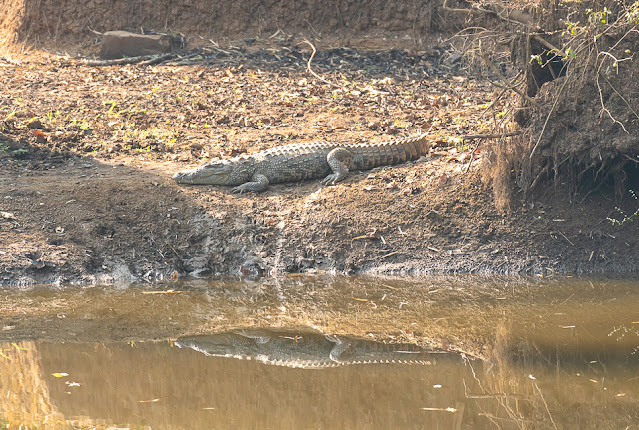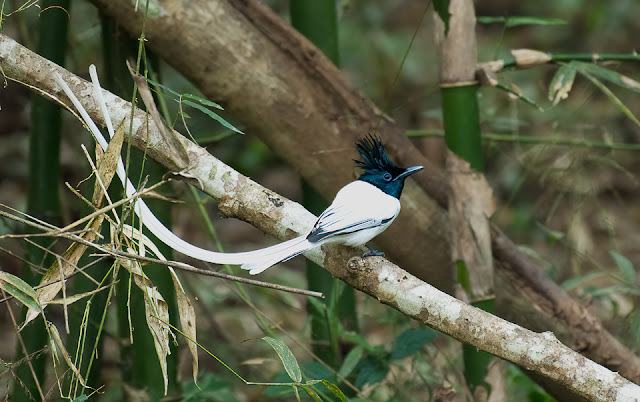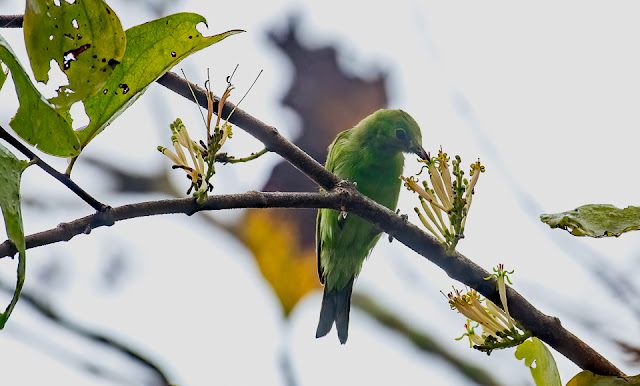 |
Sometimes I need only to stand wherever I am to be blessed. -Mary Oliver PC: Kalirajan Subramanian
|
2022 year end marked a refresh in many ways for us. After the long pandemic lull and pressing personal commitments, our family was in for a fresh start of a new phase in life. To commemorate it, we had to head to the jungles. Having been
to Karnataka's Forest Department run Jungle Lodges and Resorts in Bandipur, BR Hills, Kabini and Lakkavali long before, we decided to visit some of their other branches this time. North Karnataka beckoned and we
chose Kali Adventure Camp in Dandeli and the Old Magazine House in Ganeshgudi.
We started from Bengaluru on the new year's afternoon and reached Hubballi via road the same night around 9pm. Halting there overnight we started from Hubballi on 02Jan around 10am and checked
into the Kali Adventure Camp around noon. With a warm welcome
from the camp staff, we were taken to our river facing tent. The sight of the
beautiful Kali nadi flowing silently in our front yard, the lush green campus
with old growth trees and chirping of numerous birds instantly transported us
to a magical realm. After resting for a short while, we took a stroll around
our tent. Within minutes we could spot a Brown capped pygmy woodpecker, Grey
wagtail, Verditer Flycatcher female, Ashy drongo, Brahminy Kite, Little
spiderhunter, Asian green Bee-eater, Magpie robin, Minivets, Sunbirds and
Bulbuls. The bounty of sightings in our maiden walk in the campus, piqued our
curiosity.
 |
| Brown Capped Pygmy Woodpecker(Yungipicus nanus) PC: Kalirajan Subramanian |
 |
| Grey Wagtail(Motacilla cinerea) the winter visitor from the Himalayas PC: Kalirajan Subramanian |
 |
| Verditer Flycatcher Female(Eumyias thalassinus) PC: Kalirajan Subramanian |
We then headed
to the trademark JLR Gol ghar for lunch. As in each JLR facility, every item in
the spread was simply delectable, especially the region's authentic jolada rotti, shengai chutney and badnekkai curry. The friendly conversations with the staff,
naturalists and fellow guests added more joy to each meal of our stay. Later
that afternoon, we set out on our first jeep safari into the Kali Tiger Reserve.
Kali Tiger Reserve encompasses the Dandeli wildlife sanctuary and Anshi National Park. The Kali river flows right through the entire reserve playing a pivotal role in the ecosystem. It is home to a variety of flora and fauna many of which are endemic to Western Ghats. Hornbills are one of the major attractions in the Kali Tiger Reserve. Of the 9 hornbill species found in India, 4 of them inhabit this reserve. And this was the main objective of our visit too. To see all the four! With the company of our naturalist Mr. Dutta, we first saw a crocodile basking in the afternoon sun.
 |
| The slayer spends some time reflecting PC: Kalirajan Subramanian |
After the
big arch at the entrance came a stretch of Teak trees on either side of the
safari path. As we silently drove through, there was sudden flutter of wings to
the left of our vehicle. It looked as if two huge balls of beige and black were
tossed from one tree to another. The driver halted the vehicle at once. There
we saw the charismatic Malabar pied hornbills! Two, slowly four, eventually
around 5-7 of them were hopping between the teak trees. That was indeed one
sight to behold. The Malabar pied hornbill(Anthracoceros coronatus) is a resident breeder in India. It resides in
evergreen and moist deciduous forests. Due to habitat loss, poaching and other anthropogenic
activities their population status is Near Threatened. They are omnivorous in
their feeding habits but figs form a major part of their diet. It is interesting to note that one of the fruits they eat - the Strychnos nux-vomica(poison fruit), is toxic to many vertebrates. |
| Malabar pied hornbill (Anthracoceros coronatus) with an insect catch PC: Kalirajan Subramanian |
 |
| Count the Malabar pied hornbills (Anthracoceros coronatus) PC: Kalirajan Subramanian |
After filling our digital memories with the images of these gorgeous birds we moved forward, content and craving. At a bend we saw an Indian gaur grazing. Next to it, a white trail of exuberance started flittering around. It was a male Indian Paradise Flycatcher(Terpsiphone paradisi). He was happily feasting on the ticks plucked off the Gaur’s back and the latter in turn was much obliged for the free pest control service. A vivid demonstration of Mutualistic Symbiosis.
 |
| Indian Paradise Flycatcher(Terpsiphone paradisi) PC: Kalirajan Subramanian |
Further on,
about a dozen turtles were soaking up the evening sun over a log in a pond.
They had an Oriental darter for company. The whole ambience was so serene and
still, it looked like a picture out of a postcard. After a brief stop at the
sunset view point, it was time for us to head back to the camp. Next morning we
were taken to the Timber yard, Dandeli’s Hornbill haven. Inside the yard we
were on foot, combing the sprawling space for various kinds of birds. Soon
after, we could see Chestnut tailed starlings, Coppersmith barbets, Forest
wagtail, Brown headed barbet, Brown capped pygmy woodpecker, Black drongo,
Asian brown flycatcher, Yellow throated sparrow and hear the cackling laughter
of Malabar grey hornbills.
 |
| Forest Wagtail(Dendronanthus indicus) PC: Kalirajan Subramanian |
 |
| Brown Headed Barbet(Psilopogon zeylanicus) PC: Kalirajan Subramanian |
 |
| Yellow Throated Sparrow(Gymnoris xanthocollis) PC: Kalirajan Subramanian |
We followed
the laughter and waited below the tall trees for the birds to emerge out of the
foliage. After a short wait, the Malabar grey hornbills(Ocyceros griseus) showed themselves up.
 |
| Malabar Grey Hornbill(Ocyceros griseus) PC: Kalirajan Subramanian |
 |
| Malabar Grey Hornbill Female(Ocyceros griseus) PC: Kalirajan Subramanian |
Further down,
from few tall fruit trees a variety of bird calls emanated. There we could spot
the Yellow footed green pigeon, Grey-fronted green pigeon, White bellied wood
pecker, Malabar grey hornbills, Indian grey hornbills(Ocyceros birostris), Malabar pied hornbills and above
all the Indian Great Hornbill! As in the movie Avatar, it was as if the Toruk
decided to present herself! We simply couldn’t have asked for more.
 |
| White bellied Woodpecker(Dryocopus javensis) a timely sighting by our daughter before it disappeared PC: Kalirajan Subramanian |
 |
| Yellow Footed Green Pigeon(Treron phoenicopterus) PC: Kalirajan Subramanian |
 |
| Great Hornbill (Buceros bicornis) PC: Kalirajan Subramanian |
The Great hornbill (Buceros bicornis) is native to India, Nepal, Bhutan and South east asia. It prefers ancient old growth forests with unlogged trees in the hilly regions. They are usually seen in small groups. During mating both the genders become quite vocal. Their population status is declared by the IUCN as Vulnerable, which implies they face a higher risk of extinction unless circumstances threatening their survival improve.
 |
Great Hornbill (Buceros bicornis) PC: Kalirajan Subramanian
|
All four species of hornbills exhibit almost similar, fascinating breeding behavior. The female incubates 2-3 white eggs in a tree hole, which is blocked with a cement made of mud, droppings and fruit pulp. There is only a narrow aperture, just sufficient for the male to transfer food to the mother and chicks. And the mother and chicks void excreta through the same slit. When the chicks grow too large for the mother to share the nest with them, she breaks out and rebuilds the wall, after which both parents feed the chicks. They tend to return to the same tree-hollow for future breeding as well. Just as our house for us, their tree for them.
After a gratifying walk around the timber yard, we returned to the camp for breakfast. The mood at the camp was ebullient with the rare sighting of the Great Hornbill. Later that morning we went for white water rafting on the Kali river. An adrenaline rushing experience very well organized by the team of expert rafters from the camp. They not only made it fascinating but ensured our safety, all the while. It was surreal to be by ourselves in the tranquil expanse of the reserve, on the lap of Kali nadi.
 |
| Rafting on the gushing waters of Kali PC: The rafting team |
We had another jeep safari that evening and a birding walk in the timber yard next morning with the company of naturalist Mr.Gajja. These trips offered us sighting of Vernal hanging parrot, Plum headed parakeet, Orange and blue flycatcher, Juvenile Golden fronted leaf bird, Racket tailed drongo in addition to all the other birds mentioned earlier. We were delighted to see a Heart spotted wood pecker right at the front yard of the camp.
 |
| Golden-fronted
Leafbird Juvenile(Chloropsis aurifrons) PC: Kalirajan Subramanian |
 |
| Heart spotted
Woodpecker(Hemicircus canente) PC: Kalirajan Subramanian |
 |
| A black faced langur in a relaxed version of Paschimottanasana, as if a rural elder watching over the passersby from his porch PC: Kalirajan Subramanian |
 |
| A Brahminy kite single-mindedly scanning the Kali river below for fish PC: Kalirajan Subramanian |
 |
| This Racket tailed drongo drove a Malabar grey hornbill out of its perch. We've seen drongos, mynahs and crows to be rowdy babies. PC: Kalirajan Subramanian |
It was time to checkout. After another sumptuous breakfast we came to our tent to pack. That was when one of the camp staff visited our tent and informed that a pair of Blue bearded bee eaters were perched on the river bank just a little away from our tent. We rushed out. The camp manager and 2 other staff were already watching the birds quietly. Without causing any disturbance we also joined them. The resplendent birds were perched on a branch opening to the river. Soon, one of them flew to capture an insect and sat in another branch amidst foliage. We saw it smashing the insect in the typical Bee-eater style and devour it. The other one, remained stationed in the same branch all along.
 |
| Blue Bearded Bee-Eater(Nyctyornis athertoni) PC: Kalirajan Subramanian |
 |
Blue Bearded Bee-Eater(Nyctyornis athertoni) PC: Kalirajan Subramanian
|
It was one of the most memorable moments of our visit, just when we were about to checkout. In essence, the abundant birding opportunities and the cordial hospitality of the entire team made our visit to Dandeli, one of the most cherished.
Click here for Birding in Ganeshgudi

























Comments